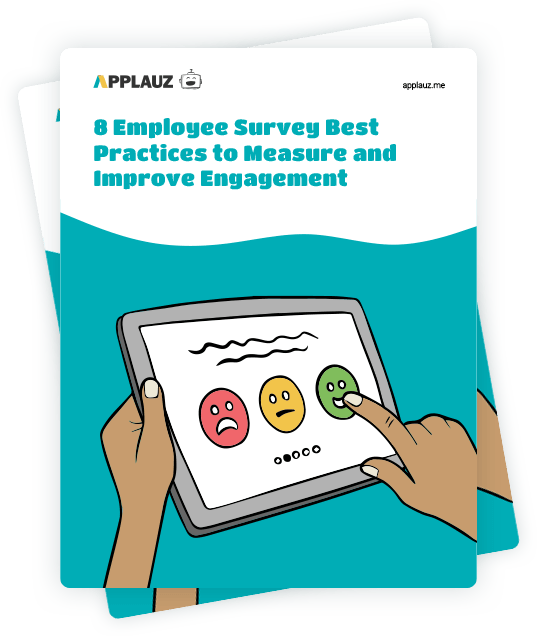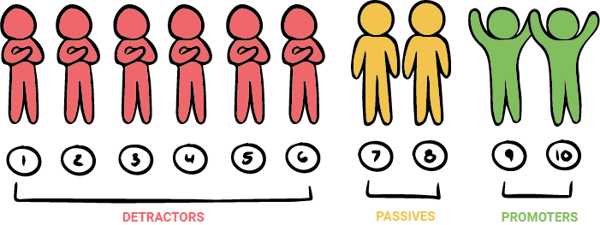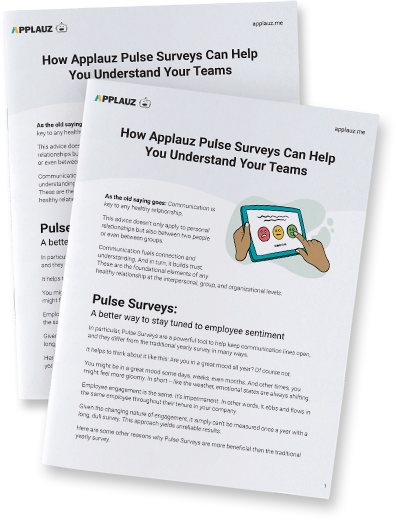Back in the '90s, management consulting firm Bain & Company developed a new method for measuring customer satisfaction.
The "magic" question was simple. Just ask your customers, "How likely is it that you would recommend our company/product/service to a friend or colleague?"
At the time, long and tedious customer satisfaction surveys dominated, so asking one quick question was a helpful alternative.
And with that simple question, Bain & Company developed an enduring method for businesses to measure the loyalty of their customers. They dubbed it NPS (Net Promoter Score).
In short, it reveals, "Who are my biggest promoters."
As the concept was introduced to corporate America, using NPS became a gold standard to measure customer satisfaction. An article was even published in Harvard Business Review, called The One Number You Need to Grow.
Since its widespread introduction in the early 2000s, the NPS has gained considerable attention in consumer research. Hinging on a single-question metric, it was heralded by some as the ultimate indicator. By 2016, over two-thirds of Fortune 1000 companies in the USA had embraced it.
What’s more, the NPS bred an equally-important employee-focused variant called the Employee Net Promoter Score, or eNPS.
eNPS emerged as an employee-centric adaptation of the customer-oriented NPS. Originally framed as, "How likely are you to recommend (product name) to a friend or colleague?" in customer research, HR departments have repurposed and renamed it for employee-focused assessments.
Today, we’re going to explore eNPS and how the employee net promoter score is important to businesses in 2024 and beyond.

8 Employee Survey Best Practices to Measure and Improve Engagement
 Understanding eNPS
Understanding eNPS
The eNPS is a robust metric that enables companies to gauge and enhance employee satisfaction and engagement. To fully understand the importance of eNPS, we’ll dive into calculating eNPS, analyzing eNPS data, and the best strategies for elevating your company’s eNPS.
What is an Employee Net Promoter Score (eNPS)?
Employee Net Promoter Score assesses an organization’s employee engagement by measuring the likelihood of employees recommending their workplace. It offers insights into overall employee satisfaction, retention probabilities, and the likelihood of employees becoming advocates for the company.
A 2023 Gallup survey, revealed that companies with low-engagement teams typically endure turnover rates that are 18% to 43% higher than highly engaged teams, underlining the pivotal role of understanding and enhancing employee engagement and reducing employee turnover.
Why Measure eNPS?
Measuring eNPS reveals a corporate landscape and company culture brimming with opportunities rather than obstacles.
The eNPS’ accessible format guarantees robust participation, swiftly delivering actionable insights within any business. With eNPS survey employee responses at hand, companies can promptly tackle concerns, nipping potential issues in the bud. Moreover, the authentic feedback collected offers a complete picture of employee sentiments and engagement levels, paving the way for tailored employee engagement strategies.
Despite acknowledging its limitations, the strengths of eNPS position it as a frontrunner for rapid, impactful, and continuous employee engagement measurement, essential for organizational success.
In short, here are a handful of eNPS advantages:
- Ease of Use: Quick and effortless for employees to complete.
- High Participation: Due to its simplicity, eNPS surveys often achieve 100% participation.
- Quick Action: Enables prompt data collection and analysis, facilitating swift issue resolution.
- Genuine Feedback: Anonymity encourages candid responses, reflecting true sentiments.
- Continuous Measurement: Quick deployment allows frequent monitoring of employee engagement, capturing trends over time
 How is the eNPS Score Calculated
How is the eNPS Score Calculated
A common method to administer eNPS is to include the question in employee surveys.
eNPS asks employees if they would recommend your company to a friend or family member. The employee responds on a sliding scale—from very unlikely to very likely.
Responses are grouped into one of three buckets: promoters, detractors, and passives.

Promoters: These are people who respond to eNPS questions with "very likely." Employees who fall into this category are your biggest supporters. They would be willing to "promote" and vouch for your company. In short, these are your most loyal people.
Passives: Are employees who give a neutral or middle response. These employees are considered "neutral." They are not active supporters of your company, but they are not talking negatively about the company either. They are somewhat satisfied with their job, but not enough to be true advocates.
Detractors: These are employees who respond as "unlikely" to recommend your company to a friend or family member. We can assume they are not too happy nor engaged at work. Your goal is to have few detractors as possible.
Tallying up the final eNPS score
At this point, you understand the response breakdown. I.e. what percentage of employees falls into each bucket? But, the total eNPS score still needs to be calculated. This can be done by subtracting the total percentage of detractors from the total percentage of promoters.

 How to Interpret your eNPS Score Results
How to Interpret your eNPS Score Results
A final eNPS score can vary from -100 to 100.
Let’s start with a negative score. If your final score is negative, you may have an employee loyalty problem on your hands.
Bottom line: A negative score means you have more detractors than promoters in your organization. Executives should take a negative score seriously. It often suggests an issue with corporate culture and engagement. The underlying cause should be quickly identified.
On the other hand, a positive eNPS score means you have more promoters than detractors. Congrats! Keep up your engagement efforts to maintain current promoters at a healthy level. The goal is to keep converting passives and detractors to promoters.
What is a Good Employee Net Promoter Score?
While there are no universal benchmarks, a general rule of thumb is to aim for a positive score. A positive score means you have more promoters than detractors, which is what you always want to strive towards! Happy employees are loyal employees.
Alternatively, if your score is negative, it’s time to investigate, as a negative score means you have more detractors than promoters. This is what you want to avoid.
That said, be wary of using eNPS as a sole measure of engagement in your workforce. Measuring eNPS should always be part of a more significant effort to gather employee feedback.
 Benchmarks and Best Practices
Benchmarks and Best Practices
eNPS benchmarks vary by industry.
Research by Perceptyx, an employee survey and analytic platform, suggests an overall eNPS benchmark of 12, while other reports show an average of 14 across different organizations.
Sector-specific benchmarks, as per Perceptyx, include:
- Telecommunications: 27
- Manufacturing: 13
- Information Technology: 26
- Healthcare: -6.5
Notably, tech companies, on average, score 26, but some boast exceptionally high eNPS scores, with some surpassing 75.
 Strategies for Improvement: How to Improve Employee Net Promoter Score
Strategies for Improvement: How to Improve Employee Net Promoter Score
Upgrading your eNPS involves converting as many employees as possible into promoters.
It's crucial to recognize that improving any employee engagement metric is an ongoing journey rather than reaching a final destination. Given the dynamic nature of satisfaction levels and the impossibility of satisfying everyone all the time, the focus should be on continuous improvement rather than achieving a static goal.
Here are 5 handy strategies geared toward improving your company’s eNPS:
-
Prioritize Internal Excellence
It's easy to get caught up in comparing ourselves to other companies, wasting considerable time and energy on external benchmarks. However, the crux lies in enhancing the employee experience and fostering engagement, happiness, and productivity from within.
Even if your organization outperforms industry averages, continuous innovation in processes and offerings is vital to stay competitive. Focus on cultivating an environment that attracts talent. We recommend integrating eNPS with a comprehensive listening strategy, incorporating continuous feedback, deep-dive surveys, and cultural assessments. This versatile approach yields valuable insights, streamlines people programs, informs intelligent business decisions, and contributes to a robust bottom line.
-
Rally your team
Enhancing your eNPS score is synonymous with elevating the satisfaction of disheartened employees, a win-win for all. It's crucial that everyone comprehends this and supports the endeavor.
To foster program engagement, ignite interest through various channels. Display posters, disseminate emails, communicate results and action plans, and distribute case studies widely. Mobilize managers to spark enthusiasm for the feedback program within their teams. Any initiative to kindle interest and momentum significantly contributes to the program's success.
-
Act on feedback
To garner support for the program, responding to every piece of feedback is important. Since your employees invest time in completing surveys, reciprocate by acknowledging and addressing their input.
Embrace both positive and negative feedback, express gratitude for their participation, and communicate plans to enhance successes and address concerns. Responding underscores their pivotal role in the initiative's success, fostering increased participation, heightened loyalty, and enhanced scores.
In addition to aggregating and sharing feedback broadly, engaging in individual conversations is invaluable. Utilize our Close the Feedback Loop tool to delve into specifics, gain context, or provide solutions while maintaining anonymity.
-
Connect with detractors
To boost your eNPS, actively engage with detractors and address their concerns. While criticism may be hard to accept, it's vital for making business enhancements. Embrace their reality, create action plans, and transparently communicate your ideas to all.
Recognize that few people complain without reason, so treat all criticisms and suggestions seriously. Maintain an open-minded approach, considering feedback as a valuable learning experience that has the potential to transform dissatisfied employees into enthusiastic promoters.
-
Track progress
Even with a thriving eNPS and successful strategies, complacency is unwarranted. Continuously monitoring your score and refining your approach is crucial. Employee loyalty is fragile, and what's successful today might not be tomorrow.
Recognize that eNPS alone may not address all business aspects. Blend it with pulse surveys and other metrics for comprehensive insights into employee experience. This holistic approach ensures continual improvement, adapting to evolving employee needs and contributing to a thriving organizational environment.
Tip: Some employee survey tools and solutions will calculate the eNPS score for you automatically.
Now, you know your eNPS score. But what does it mean? And what should you conclude from the results?
Let’s dive a bit deeper to understand how you should interpret your eNPS score.
eNPS: one part of a larger employee surveys strategy
eNPS score measures only one dimension of employee satisfaction and happiness. In other words, managers shouldn't rely on eNPS as a sole indicator of total employee engagement.
So, how can managers capture the "big picture" of employee engagement?
Employee surveys must consist of questions that measure employee engagement on multiple levels, such as those illustrated in the image above.
In addition to eNPS, employee surveys must also include questions that ask how employees feel about career and growth opportunities, compensation and benefits, etc.

How Applauz Pulse Surveys Can Help You Understand Your Teams
 Final Thoughts
Final Thoughts
Strong surveys should measure employee satisfaction in many areas of the employee experience. Properly surveying employees will reveal which areas need attention.
Achieving a high eNPS involves a multifaceted approach and remember: success needs to be continually monitored.
In closing, embracing the essence of eNPS goes beyond a numerical score—it's about shaping a workplace culture where employee satisfaction and engagement flourish. By prioritizing internal excellence, rallying teams, responding to feedback, connecting with detractors, and continuously tracking progress, businesses can create a dynamic environment where employee loyalty, satisfaction, and advocacy thrive. In the realm of eNPS, success lies not just in the score but in the commitment to sustained excellence.
Pro Tip: Administering employee surveys is the recommended first step in building a well-rounded employee engagement program. Identifying employee pain points via surveys will allow you to better prioritize and roll out HR initiatives.
About the author
 Michelle Cadieux
Michelle Cadieux
Michelle is a content writer for Applauz. She holds a Bachelor's degree in Psychology from Concordia University, and she has been writing about work and employee happiness for over five years.


